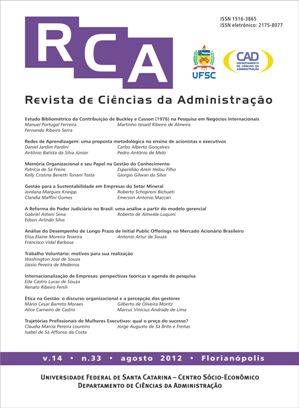Network learning: a methodological propose to shareholders and executives education
DOI:
https://doi.org/10.5007/2175-8077.2012v14n33p25Abstract
DOI: http://dx.doi.org/10.5007/2175-8077.2012v14n33p25
This article aims to analyze the dynamics of the learning networks operation of business and the differential of this methodological practice to other conventional models of teaching. The review of the epistemological theories of learning and educational psychology identified constructivism collective (LAROCHELLE et al., 1998) as the approach that most closely resembles conceptions of teaching in network format. To understand the way they are planned and organized networks and their distinctions for other types of courses targeted at executives use the methods of case study and thematic analysis. The study highlight the differences in entrepreneurial learning networks, still little diffusined in Brazil, for the traditional teaching methods taught in the open courses postgraduate to the public and in-company to complement and update the learning people in executive business function.
Downloads
Published
How to Cite
Issue
Section
License
The author must ensure:
- that there is complete consensus among all co-authors to approve the final version of the paper and its submission for publication.
- that their work is original, and if the work and/or words of others have been used, these have been duly acknowledged.
Plagiarism in all its forms constitutes unethical publishing behavior and is unacceptable. RCA reserves the right to use software or any other methods of plagiarism detection.
All submissions received for evaluation in the RCA journal are screened for plagiarism and self-plagiarism. Plagiarism identified in manuscripts during the evaluation process will result in the submission being archived. In the event of plagiarism being identified in a manuscript published in the journal, the Editor-in-Chief will conduct a preliminary investigation and, if necessary, retract it.
Authors grant RCA exclusive rights of first publication, with the work simultaneously licensed under the Creative Commons (CC BY) 4.0 International License.

Authors are authorized to enter into separate, additional contractual arrangements for the non-exclusive distribution of the version of the work published in this journal (e.g., publishing in an institutional repository, on a personal website, publishing a translation, or as a chapter in a book), with an acknowledgement of its authorship and initial publication in this journal.
This license grants any user the right to:
Share – copy, download, print, or redistribute the material in any medium or format.
Adapt – remix, transform, and build upon the material for any purpose, even commercially.
According to the following terms:
Attribution – You must give appropriate credit (cite and reference), provide a link to the license, and indicate if changes were made. You may do so in any reasonable manner, but not in any way that suggests the licensor endorses you or your use.
No additional restrictions – You may not apply legal terms or technological measures that legally restrict others from doing anything the license permits.


